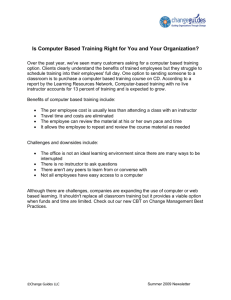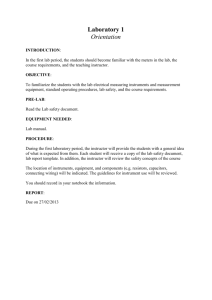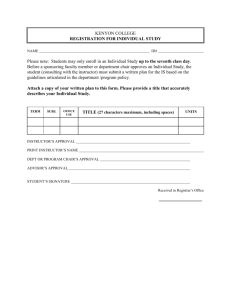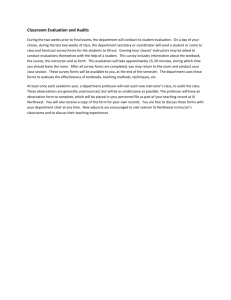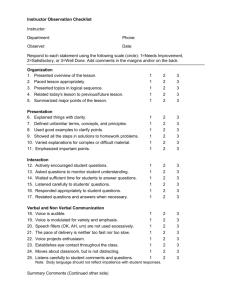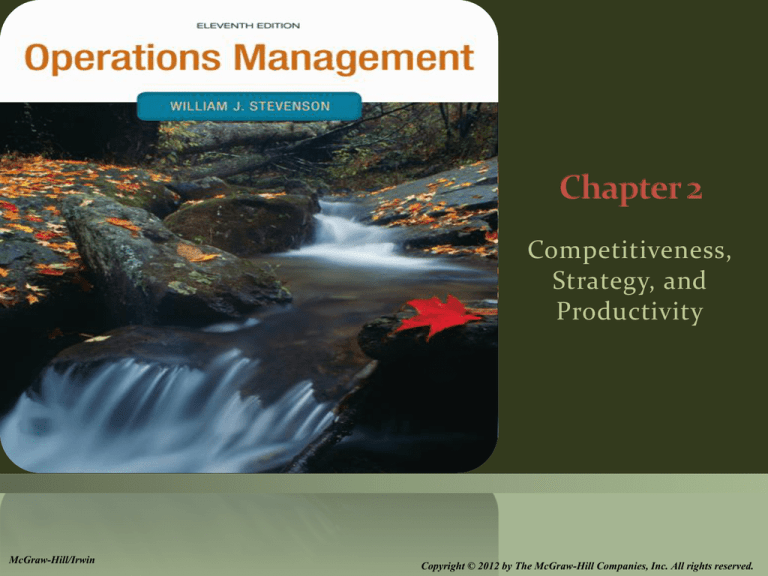
Competitiveness,
Strategy, and
Productivity
McGraw-Hill/Irwin
Copyright © 2012 by The McGraw-Hill Companies, Inc. All rights reserved.
Better quality, higher productivity, lower costs, and the
ability to respond quickly to customer needs are more
important than ever and…
the bar is getting higher
Instructor Slides
2-2
This chapter focuses on three separate, but related
that are vitally important to business organizations
Competitiveness
Strategy
Productivity
Instructor Slides
2-3
Productivity
A measure of the effective use of resources, usually
expressed as the ratio of output to input
Productivity measures are useful for
Tracking an operating unit’s performance over time
Judging the performance of an entire industry or
country
Instructor Slides
2-4
High productivity is linked to higher standards of
living
As an economy replaces manufacturing jobs with lower productivity
service jobs, it is more difficult to maintain high standards of living
Higher productivity relative to the competition leads
to competitive advantage in the marketplace
Pricing and profit effects
For an industry, high relative productivity makes it
less likely it will be supplanted by foreign industry
Output
Productivity=
Input
Output
Ouput Output
Partial Measures
;
;
Single Input Labor Capital
Multifactor Measures
Total Measure
Output
;
Multiple Inputs
Ouput
;
Labor+Machine
Goods or services produced
All inputs used to produce them
Output
Labor+Capital+Energy
Units produced: 5,000
Standard price: $35/unit
Labor input: 500 hours
Cost of labor of $25/hour
Cost of materials: $5,000
Cost of overhead: 2x labor cost
What is the
multifactor
productivity?
Multifactor Productivity=
=
Output
Labor+Material+Overhead
5,000 units $35/unit
(500 hours $25/hour)+$5,000+(2(500 hours $25/hour))
=4.12
What is the implication of a unitless measure of productivity?
Instructor Slides
2-9
Current productivity-Previous productivity
Productivity Growth =
100%
Previous productivity
Example: Labor productivity on the ABC assembly line was 25 units per hour in
2006. In 2007, labor productivity was 23 units per hour. What was the
productivity growth from 2006 to 2007?
Productivity Growth =
23 - 25
100% 8%
25
Average Annual Percent Change
MFP Growth in the Private Non-Farm Business Sector
5
4
3
2
1.9
1.1
1
0.4
1.3
0.6
0
1948-1973
1973-1990
1990-1995
1995-2000
2000-2007
Service sector productivity is difficult to measure and
manage because
It involves intellectual activities
It has a high degree of variability
A useful measure related to productivity is process yield
Where products are involved
ratio of output of good product to the quantity of raw material
input.
Where services are involved, process yield measurement is
often dependent on the particular process:
ratio of cars rented to cars available for a given day
ratio of student acceptances to the total number of students
approved for admission.
Instructor Slides
2-13
Methods
Capital
Technology
Instructor Slides
Quality
Management
2-14
1.
Develop productivity measures for all operations
2.
Determine critical (bottleneck) operations
3.
Develop methods for productivity improvements
4.
Establish reasonable goals
5.
Make it clear that management supports and encourages
productivity improvement
6.
Measure and publicize improvements
Don’t confuse productivity with efficiency
Competitiveness:
How effectively an organization meets the wants and
needs of customers relative to others that offer similar
goods or services
Organizations compete through some combination of
their marketing and operations functions
• What do customers want?
• How can these customer needs best be satisfied?
McDonald's brand mission is to
"be our customers' favorite place and way to eat." Our
worldwide operations have been aligned around a global strategy
called the Plan to Win centering on the five basics of an
exceptional customer experience -- People, Products, Place,
Price and Promotion. We are committed to improving our
operations and enhancing our customers' experience.
http://www.mcdonalds.com/corp/about/mcd_faq/student_research.html
FedEx Corporation will produce superior financial returns for its
shareowners by providing high value-added logistics,
transportation and related information services through focused
operating companies. Customer requirements will be met in the
highest quality manner appropriate to each market segment served.
FedEx Corporation will strive to develop mutually rewarding
relationships with its employees, partners and suppliers. Safety
will be the first consideration in all operations. Corporate activities will
be conducted to the highest ethical and professional standards.
http://ir.fedex.com/documentdisplay.cfm?DocumentID=125
Instructor Slides
2-18
Product and service design
2. Cost
3. Location
4. Quality
5. Responsiveness
6. Flexibility
7. Inventory management
8. Supply chain management
9. Service
10. Managers and workers
1.
Organizational
Strategy
Examples of Companies or
Services
Operations Strategy
Low Price
Low Cost
U.S. first-class postage
Wal-Mart
High Quality
High performance design and/or
high quality processing
Sony TV
Lexus
Consistent Quality
Coca-Cola; electric power
Short Time
Quick Response
On-time delivery
McDonald’s Restaurants
Express mail
FedEx; One-hour photo
Newness
Innovation
3M
Express mail
Variety
Flexibility
Volume
Burger King (Have it your way”)
McDonald’s (“Buses Welcome”)
Service
Superior customer service
Disneyland
IBM
Location
Convenience
Supermarkets
Mall Stores
Operations strategy
The approach, consistent with organization
strategy, that is used to guide the operations
function.
Decision Area
What the Decisions Affect
Product and service design
Costs, quality, liability, and environmental issues
Capacity
Cost, structure, flexibility
Process selection and layout
Costs, flexibility, skill level needed, capacity
Work design
Quality of work life, employee safety, productivity
Location
Costs, visibility
Quality
Ability to meet or exceed customer expectations
Inventory
Costs, shortages
Maintenance
Costs, equipment reliability, productivity
Scheduling
Flexibility, efficiency
Supply chains
Costs, quality, agility, shortages, vendor relations
Projects
Costs, new products, services, or operating systems
Quality-based strategy
Strategy that focuses on quality in all phases of an
organization
Pursuit of such a strategy is rooted in a number of factors:
Trying to overcome a poor quality reputation
Desire to maintain a quality image
A desire to catch up with the competition
A part of a cost reduction strategy
Instructor Slides
2-23
Time-based strategies
Strategies that focus on the reduction of time needed
to accomplish tasks
It is believed that by reducing time, costs are lower, quality
is higher, productivity is higher, time-to-market is faster,
and customer service is improved
Instructor Slides
2-24
Areas where organizations have achieved time
reductions:
Planning time
Product/service design time
Processing time
Changeover time
Delivery time
Response time for complaints
Instructor Slides
2-25
Agile operations
A strategic approach for competitive advantage that
emphasizes the use of flexibility to adapt and prosper in
an environment of change
Involves the blending of several core competencies:
Cost
Quality
Reliability
Flexibility
Instructor Slides
2-26

